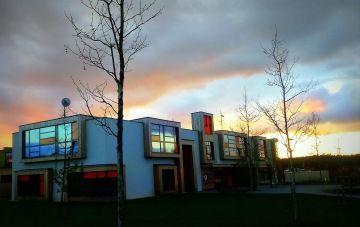Open Gate students visited CERN

Three Oktava students visited CERN as a special treat at the end of their studies. Students accompanied by two members of staff spent a day at the Swiss Nuclear Research organization.
These are some comments from them:
Michaela Flegrova: “Regarding our trip to CERN one could ask if it really was worth it. We were away for 59 hours, out of which we spent 20 hours in the car, 4 hours at petrol stations and parking lots, we slept for 15 hours, and spent 7 hours walking in Geneva. We were in the actual CERN facilities only for about 6 hours. We drove through four countries, crossed the French-Switzerland border about five times in each direction and with the ratio of two teachers to three students we were one of the safest trips in OG history. Were the 6 hours worth all of this?
They were. Those were the 6 hours we had been fighting for two years, the 6 hours we had been looking forward to for two years, the 6 hours that proved us that the American dream still exists. And it was not just about these 6 hours anyway - every single one of those 59 hours counted as a part of the experience!”
Petr Manas: “The first word that now, after the visit, comes to my mind when talking about CERN is: HUGE (I wanted to go with ‘awesome’, but that’s just too mainstream). The famous particle accelerator LHC is 27 kilometers long, stretching from Switzerland to France, but it is by far not the only huge thing connected to CERN. The laboratories themselves house over 2,500 people, like LHC, they stretch over the border of two countries, and it takes about half an hour to walk from one end to the other. Apart from that, there are also the detectors. Observing 600 million particle collisions per second, these building-sized detectors use cutting-edge technology to learn about all the universes mysteries. Now the fun nerdy part: numbers! The large numbers include, for instance, the 9,593 magnets that are distributed around the ring, or the 300 trillion (3x10^14) protons flying through the collider at the speed of light during an experiment. To give some space to the small numbers too, imagine that the LHC is running at the incredible temperature of 1.9 K (-271°C), making it the coldest place in the known universe! These are just the couple of fun facts that came to my mind of the many things I learned during our visit. If you ever happen to go through Geneva or close by, be sure to check out the CERN laboratories – it’s definitely worth the visit!”
Michaela Flegrová and Petr Maňas